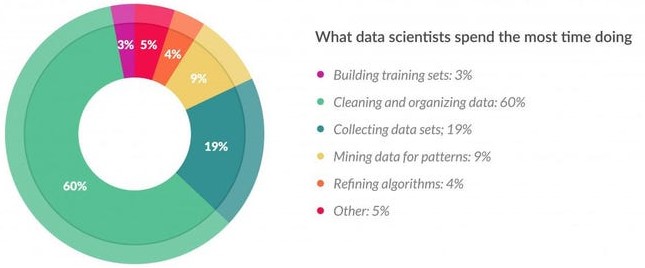Data is significant for any business. However, to flourish gathering data alone is not enough. You should be able to make sense of the vast information being generated every day. But to understand such huge volumes of data is an overwhelming task. Hence, it is important to first have a clear understanding of the type of data you are trying to collect. Then, it’s vital to aggregate data. Aggregated data allows for faster decision-making processes that help businesses move from reacting to planning.
But data aggregation is not a simple task, and mistakes can cost a huge expense. This is where data wrangling helps you.
Understanding data aggregation
Data aggregation is the process of compiling multiple pieces of data into a single format. This is important because it allows for better analysis of large datasets that are often difficult to access and understand on their own. By aggregating data, businesses can identify trends, relationships between variables, and patterns that would otherwise be invisible. As a result, businesses make informed decisions about marketing strategies and initiatives.
A simple example of data aggregation is compiling website traffic statistics. This could involve logging in to a tracking platform every day or hour and recording the number of visits each page has received. After collecting a sufficient amount of data, you can sort the relevant data out of it and then begin analyzing it. This way you gain insights into how your content is performing and what changes may need to be made.
Data wrangling: What is it?
Data wrangling is the process of converting raw, unstructured data into an easily and quickly accessible format. It involves cleaning, formatting, shaping, and aggregating data in order to make it easy to understand. For example, adding missing values, configuring tables correctly, identifying trends and patterns in the data, and making decisions based on the results.
Imagine you are conducting an online survey. Aside from collecting data, it requires consistently managing and aggregating data collected from surveys. Data wrangling plays a key role in successful online survey research. It ensures that all data is entered accurately, reducing bias and inconsistencies in responses, aggregating the usable information, and providing analysts with timely reports so they can make informed decisions about line research.
5 Use cases of data wrangling in businesses
- Aggregates data effectively
Are you breaking your head to sort the right data from the vast data you have access to? You’re not alone. You’d be surprised to know that according to Techjury, 95% of businesses are struggling to handle unstructured data. This is due to the increase in data-driven decision-making, and the need for faster data access. Clearly, this problem needs to be addressed!
Understanding how to aggregate data is essential to make sense of the massive amount of information that is being generated every day. This is what data wrangling does. It helps in sorting through all the data so that you can identify trends or make informed decisions. Here’s an example of aggregated data from Starbucks created using Tableau.
- Helps businesses to study their customer base
When it comes to running a successful business, understanding and tracking customers’ interests is one of the most important tasks. By doing this, you can identify which products or services are selling well and which ones need to be revised or discontinued. Further by understanding what interests and concerns your customers, you can tailor content that is relevant to them.
Data wrangling is the process of analyzing how customers interact with your products or services, what types of conversations are happening online and offline, which marketing campaigns are most successful, where traffic comes from on website pages, and more. By understanding these factors carefully, businesses can optimize their operations and improve customer engagement overall. Here’s an extensive Google Analytics report of an apparel business tracking the geography, interests, and traffic of its users.
- Enables businesses to track changes
The way your users interact with your business through digital channels is evolving every minute of the day. Hence, you need to keep up with the latest trends and changing consumer behavior. By being updated on the changes in data, you can utilize data correctly and optimize your strategies accordingly.
Data wrangling enables companies to respond quickly and effectively when changes happen within their ecosystem. Further, it helps you to compare and get real-time insights into performance and results. For example, in the last week, if your website has noticed a sudden surge in traffic then you can analyze what strategies caused the improvement and implement the same. This way the managers can make informed decisions about how best to allocate resources.
- Helps to break down data
Data is an important component of a business, and it should be treated as such. However, one of the biggest problems is that it is often complex and difficult to understand. This in turn leads to inefficient operations and mismanaged resources. Additionally, complex data can also slow down decision-making processes and hamper innovation.
Data wrangling helps to simplify complex information by streamlining it into simple formats that users can easily consume. It also allows for quick analysis of large datasets in order to identify patterns or insights that may not have been apparent at first glance. As a result, businesses can create better strategies while saving time and resources.
- Allows everyone to understand data
For a business to leverage data to the best everyone should be able to understand the data without hierarchy. By taking the time to clean and transform the data into a form that is easy to use and interpret, we are all able to make sense of it. Further, data visualization automates the analysis and presentation of data so that it is easy to understand and accessible for all users. This makes it possible for beginners to experts to execute complex analyses involving large datasets faster than ever before.
Data wrangling is a huge task that needs careful planning and execution. We at Xract.io understand how overwhelming it can be to keep track of all the data in your business. Therefore, we’ve come up with an efficient platform to help you easily manage your data without any trouble while extracting insights from them. Sign up for a free demo with us today!








